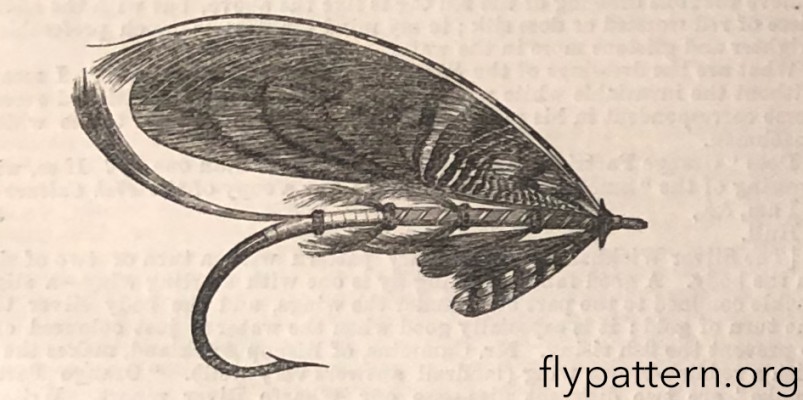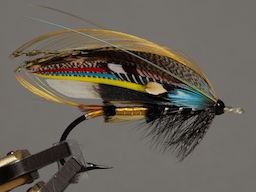From "The fishing gazette" - October 11th, 1884 IN continuing the remarks relating to throat hackles, &c., I may remind the student that the fibres of these feathers, whether they are wound spirally or set in as butts, should increase gradually in length from the tag to the wings, When short ones were fashinonable we used to draw a square with a pencil and lay the fly inside across the centre, placing its head to the right. The rule was for the throat hackle to extend to a diagonal line from the top left angle to the bottom right, and no farther. I believe I have tried them all ways, not in one river but in several, to see which is best, and decidedly prefer those that nearly or quite reach the barb of the hook. The chief secret of success with long hackled flies is to present them properly. To shake the rod about spasmodically, giving the fly fits and starts, and converting it into a rough and tumbled mass of riotous fibres, is not much use. Sometimes even for all that the fish may be enticed from under the rent red rocks, and rush through the swirling streams; but nine times in ten they would be as likely to take a birch broom in a fit. Upon another occasion - in "Odds and Ends" most likely - we will dwell a bit upon that subject.
One cannot offer any general standard as to the amount of hackle at the throat; the best plan, I think, is for strangers to follow the example of the most successful angler in the district. We often hear that some rivers require a good batch, while in others a mere nothing will suffice; but I cannot believe in any of these hard-and-fast laws, and so rarely listen to them; indeed, I have frequently "landed" by offering these fastidious fish something or other entirely novel, and opposite to all rule and custom. How inexplieable are the frequent freaks of salmon. For instance, not very long ago from one pool in a few hours I had a regiment of six on the bank, all taken with the king of flies - Jock Scott; and although there were fresh fellows up in the catch daily - for the water was in good fettle - the fly failed afterwards entirely. I tried several others I thought likely at odd intervalls, but to no purpose; at last, coming to the end of my invitation, I whipped up a monster "Black Eagle," minus wings. The first time down I hooked and lost a jiggering 10 or 12-pounder, and banked a beauty of 13lb. the next.
I can quite believe that salmon fidget and lose their "sense of safety" in haunts that have been very much disturbed by similar or any other means. They may just take shelter perhaps and no more, but not even that sometimes. During a netting expedition a few years since a somewhat remarkable opportunity happened of noticing their little pranks, and that, too, in a good stretch of water where the drag-nets had swept the bed of the river almost spick and span.
There was a small run of fish coming up, "all of a heap" (as the local paper put it), and the moment they came upon this freshly-swept half-moon arena some of them would run over it like lightning, while others danced about like a wild bird caged. Now, where rocks are pretty well perpendicular - although they may be smooth - as the water becomes vapid and dead, so does mess and much gather upon them. We may well fancy all that cut and gashed about in places, especially in a small pool, not only by the line in the playing two or three salmon, but also by their tails, which surely flip off and expose to view conspicuous patches of bright stone, or may be chalk.
"Something has put the fish off," we say. And how can we account for such matters? Indeed, any decision would be in a degree doubtful. We can come to our own conclusion, and we may form our own opinion, and keep it if we like, which is both pleasant and cheap; but we really have to rest content with probability, after all, as we cannot get beyond, for our best reasonings will reach no further. However, let us always balance arguments, and make the most of them in the hope of progressing, and let us take care at the same time, even if we favour preferences, to fight shy of all prejudices, so that we may store up in that philosophical chimera - the mind - principes which take their rise in, and rest upon the best of all evidence - Practice.
We have this week another splendid novelty in flies, and the "Lapwing" is one of the most beautiful of all these patterns. It is suited to every river, and can be dressed any size, certainly from the smallest up to four or five sizes larger than the illustration. The enamelled Thrush has no great reputation; indeed, I believe until now it has never been quite understood, inasmuch as the feathers have been misplaced, and not worked correctly.
It is very odd that we always practise more easily what we already know; but would it not be better to pay a little attention to what others glory in. Their theory and practice may possibly be a cut above our own, and the chances are we should at least learn something,. Solid and substantial advice to quicken every sense and nerve to acutest perception is what we want, and that is only capable of being imparted from minds freed from bias and misconception after long and close experience.
The blue feathers in the wings here are from under the tail of the bird, though along its back there are others, small, yet equally effective, and could be used similarly even for our diminutive grisle flies. This Thrush is about one-third the price of a light blue Chatterer, and may be bought at almost any of the table shops. The fly is described:
Tag: Silver twist and green silk (same shade as the green feathers from Macaws).
Tail: Topping.
Butt: Black herl.
Body: In four equal sections, the first three butted with the herl. No. 1 division, silver tinsel, with canary Toucan above and below. No. 2, topping coloured floss silk, ribbed with fine oval tinsel, and the ordinary Toucan above and below. No 3, orange silk, ribbed likewise, with Red Crow above and below. No.4, red claret silk, ribbed again as before.
Throat: Five or six Red Crow and Jay feathers, as illustrated.
Wings: Ten Enamelled Thrush, as shown and described.
Cheeks: Summer Duck and Jungle Cock, two toppings over.
Horns: Amherst pheasant.
Head: Black herl.
I am told that this bird is called the Jaffa Finch in Syria. Fishermen, or rather fly makers, always know it as the Enamelled Thrush. We had better make a note of it, though I do not like alternating names, as that only causes confusion.
|

